

Originally posted May 29, 2016
In earlier Guns of the Week, we've seen a couple of different guns described as being based on, or derived from, or at least inspired by the Walther PP, so a little while ago I thought it was high time I actually got a PP and did some background on that. It didn't quite work out like that, but in a way that's really interesting.
Let's start with the history. This is a Walther PP, albeit not my Walther PP, it's a Wikimedia image.

PP is short for Polizeipistole, which is an indication of its original intended use: it was meant to be carried by the German police. The PP entered production in 1929 as one of Europe's many, many .32 ACP/7.65mm Browning semiautomatic pistols. Like most of them, it has a straightforward blowback operating system. Mechanically, the PP's signature feature is the fact that the barrel is fixed to the frame, so that only the slide moves during operation.
As we have seen, there have been many later pistols that are similar to, inspired by, or in some cases outright dupes of the PP. Most of them end up being labeled "the $nationality PP" for simplicity's sake, although in many cases there are other differences and the imitation is not as complete as it first appears. The Makarov, for instance, was called the Soviet PP, and the CZ 82 the Czech PP, and so forth, but neither is an outright copy.
Walther themselves produced two variations on the PP theme, one larger than the original and one smaller. The larger version, the MP (Militarpistole), was developed in 1931, in hopes of winning a contract to supply the German Army with a replacement for the DWM P08 (Luger) pistol. The German armed forces were then still at their Versailles-mandated reduced size, but even then, two years before the Nazis took power, it was an open secret in Germany that they planned to start rearming in earnest soon, treaty obligations be damned. Walther hoped to get in on the bonanza of contracts that would surely follow.
They weren't going to do it with the MP, however, for—as many other firearms designers have learned to their chagrin—a straight blowback action will only take you so far, and without major compromises in weight and spring resistance that no operator is going to be happy with, it won't take you to 9mm Parabellum. Walther recognized that early on, and they briefly thought to resolve it using a hesitation-lock system like that found in the Pedersen-designed Remington Model 51, but that proved too expensive and complicated to manufacture.
Ultimately, the quest for a military pistol contract would take Walther from the MP through the short-lived AP (Armeepistole) to the HP (Heerespistole, which also means "army pistol"), which was adopted with a few visually-minor modifications as the P38. By then, though, it bore little resemblance to the original PP; and though it may will be its own Gun of the Week someday, we can leave it for now and get back to the original track.
The other "native" variation of the PP is the rather more famous PPK, which is smaller than the original. The "K" stands for Kriminalmodell, "criminal model"—which does not, ha ha, mean it was intended for the use of criminals. It was rather what an American company would probably have called the "detective's model"; police detectives in Germany are called the "criminal police", as in they're meant to investigate crimes, not commit them. By modern standards this seems a little silly—the PP was already not a large pistol, and you wouldn't think to look at one that plainclothes officers would need a smaller version—but at the time, concealed carrying mainly meant sticking it in a coat pocket. The PPK achieved pop culture notoriety when it became James Bond's sidearm in Doctor No, which meant (since the movies, unlike the books, started there) that it was always his sidearm on film. The character is frequently shown with one in promotional images even today, when its presence is markedly anachronistic.
So I said at the outset that my plan to get hold of a PP for this article didn't quite work out that way. Well, it did and it didn't. Here is the pistol I ended up acquiring.
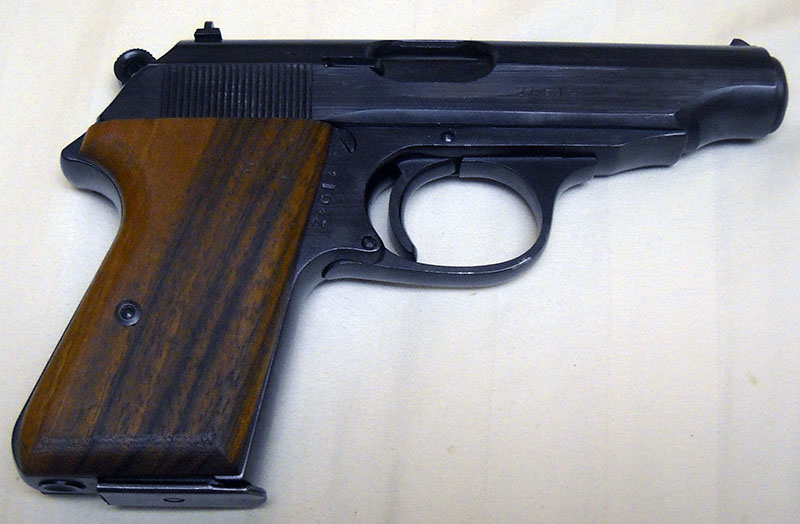
From this side, it looks totally legit, except for those odd wooden grip panels. Real PPs have plastic (or, if they're old enough, Bakelite) grips, usually with the Walther banner molded on them somewhere. These don't even look particularly finished. The profile is correct, though.
Over on the other side, the plot thickens.
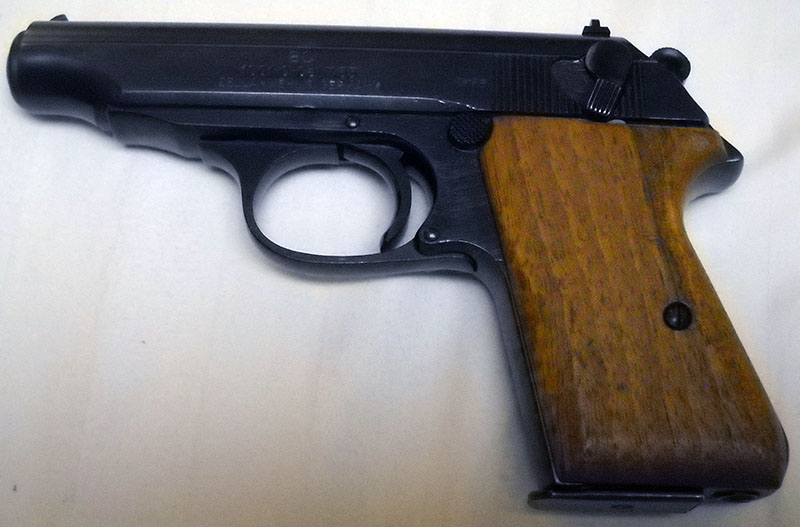
None of the usual markings are in evidence here. No Walther banner, no "made in West Germany", nothing. Just an odd code number and some lettering that doesn't quite seem like it goes with it...
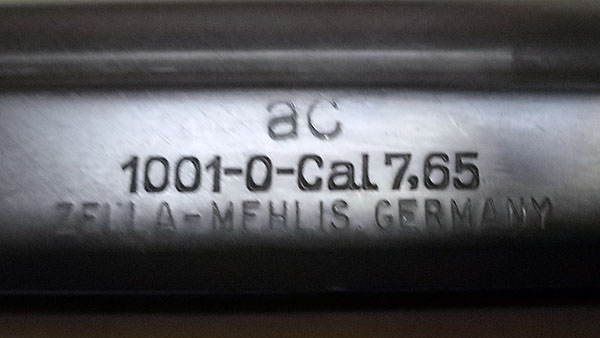
... and what appears to be an odd combination of pre- and postwar German proof marks.
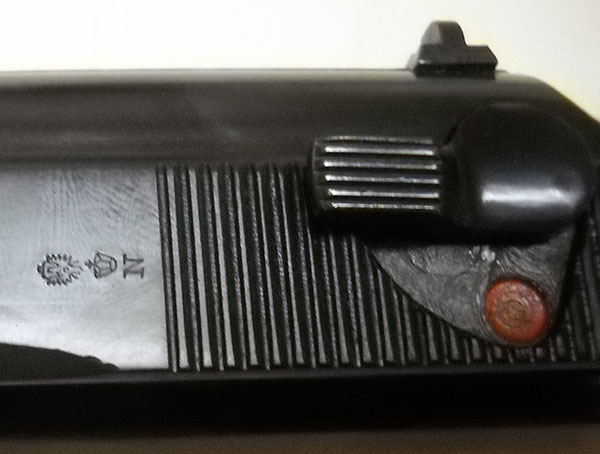
The German government replaced the older "crown over N" nitro proof mark with an "eagle over N" version in 1940... so what is going on here?
What is going on here, as it turns out, is that this is not a Walther PP; it's a P1001-0. That "eagle over crown over N" mark is the nitro proof mark of the postwar East German national proof house at Suhl. You will thus usually see the P1001 described, when it is described at all, as an East German copy of the PP.
Except... it isn't really a copy, depending on how you look at it. See, up to and including World War II, Walther's headquarters was in the town of Zella-Mehlis in Thuringia. After the war, this ended up as part of the Soviet zone of occupation, and the company's owners, engineers, and so on prudently decamped to the city of Ulm, which was in the American zone, in what is now the state of Baden-Wüttemberg... but the factory and tooling, and I would guess a significant percentage of the regular workforce, remained in Zella-Mehlis. So... how much of a copy can something be when it's made on the same machines, in the same plant, probably by many of the same people, as the original?
If it was. As is so often the case with the history of the Soviet bloc, these waters are pretty muddy. Some accounts I've found say, as above, that the P1001 was made in the old Walther works in Zella-Mehlis as an extension of PP manufacture; but others maintain that the plant was blown up by the Russians early in the Occupation, in late 1945. That would, at best, mean that they were made in some other factory in Zella-Mehlis, and at worst, that the "Zella-Mehlis" marking is a total lie. Either way, if it's true—and that kind of pointlessly punitive behavior is in no way out of character for the Red Army in occupied Germany—the idea that the P1001 is-and-yet-isn't a PP clone is more of a stretch than I originally thought. Which is slightly disappointing, but I have no hard data either way.
Almost as convoluted as its origins is the path this pistol took to end up here in the US. During the Cold War, East Germany officially disdained exporting to the West, as most of the Communist bloc did; but privately, the East German government was as fond of hard currency as anybody else. As such, the story I've seen (and I can't vouch for its accuracy, but it's plausible) is that they sold a bunch of firearms to the West, semi-deniably, through a neutral intermediary: the Swiss firm of Hämmerli. It was Hämmerli, I'm told, who added the incongruous-looking "ac" and "ZELLA-MEHLIS, GERMANY" marks (true or otherwise) to the P1001s they sold on, which originally had only the center line of the left-side markings.
The "ac" mark is particularly fun because it doesn't mean anything, it's just meant to look like something that appears on some real PPs. It was originally a secret manufacturing code used by the Nazis in place of the Walther logo on issue P38s, in hopes that Allied troops who captured them wouldn't be able to figure out where they were made and bomb the factory. So in an abstract sort of way, it kind of does mean "made in Zella-Mehlis", but only through a pretty extreme cargo-cult interpretation.
Hämmerli also added their own markings to the guns they resold, but cleverly put it on the inside, where it can only be seen with the slide removed.
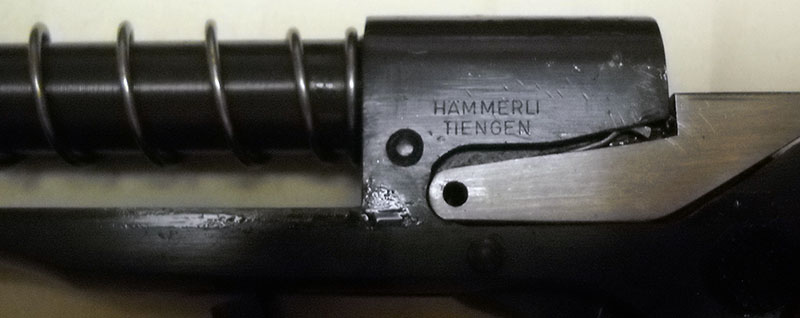
This particular pistol has no other importer or reseller markings on it, which indicates that it entered the United States prior to 1968.
Disassembly works as we've seen before in PP-like pistols, as this is where it all started. It starts with locking the slide open, removing the magazine, and then pulling down on the trigger guard to unlock the slide.
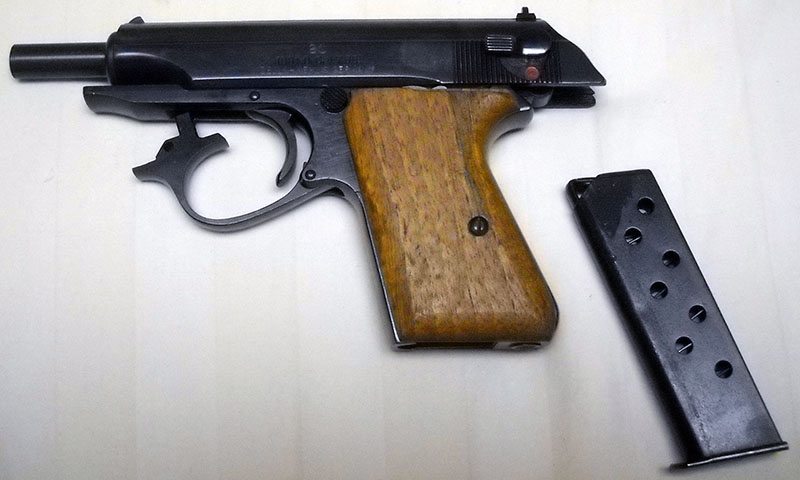
With that done, the slide can be pulled a little farther back, then lifted up at the back and finagled off the front, leaving the fixed barrel in place with the recoil spring around it.
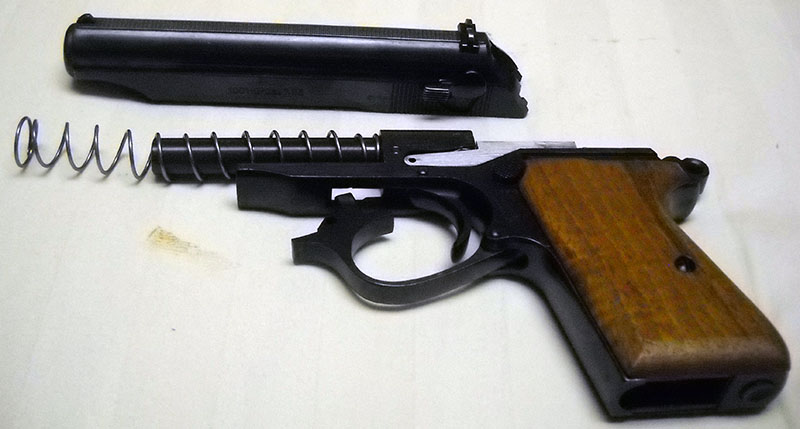
Compare the disassembly of the Polish P64:
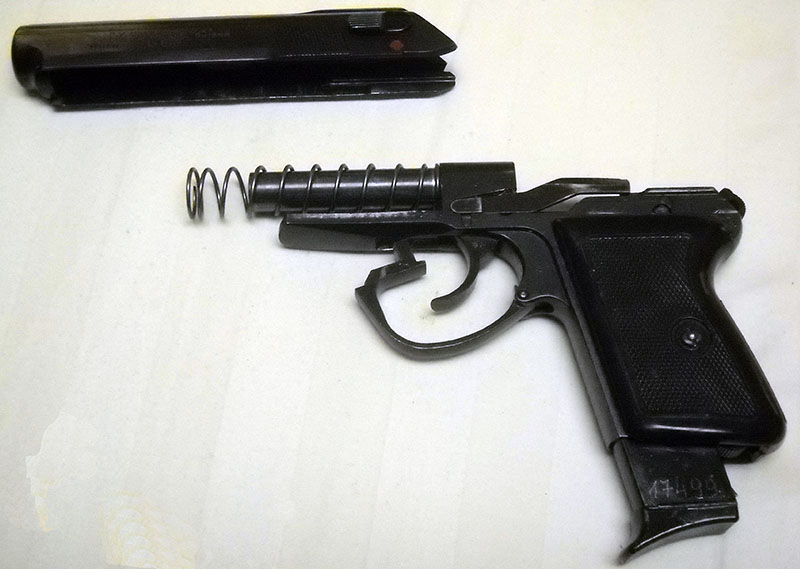
and CZ 82:
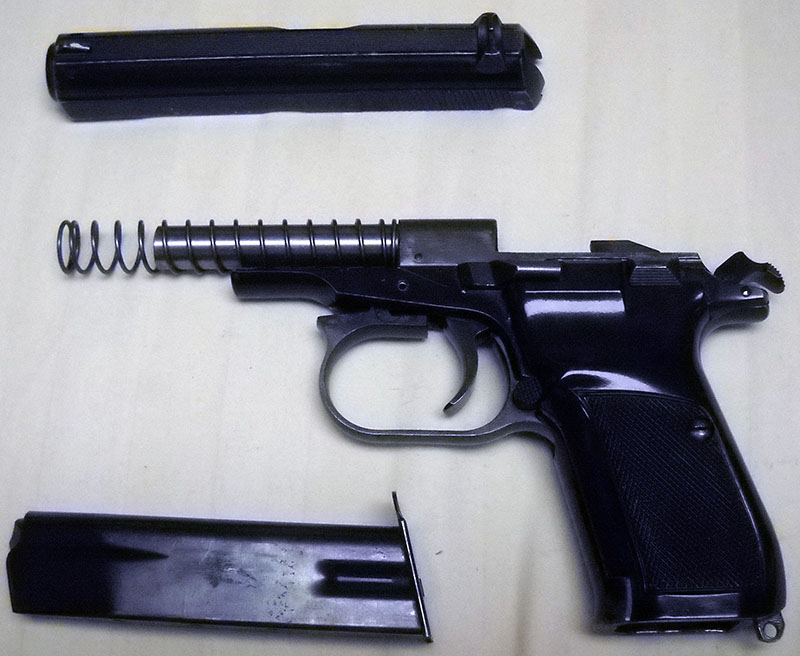
The CZ 82 improves on the system somewhat by making the trigger guard a positive unlock lever, which stays that way until relocked (as opposed to the PP's, which is under constant spring tension and has to either be held down while disassembling or moved a little bit to the side so it won't go back in the hole).
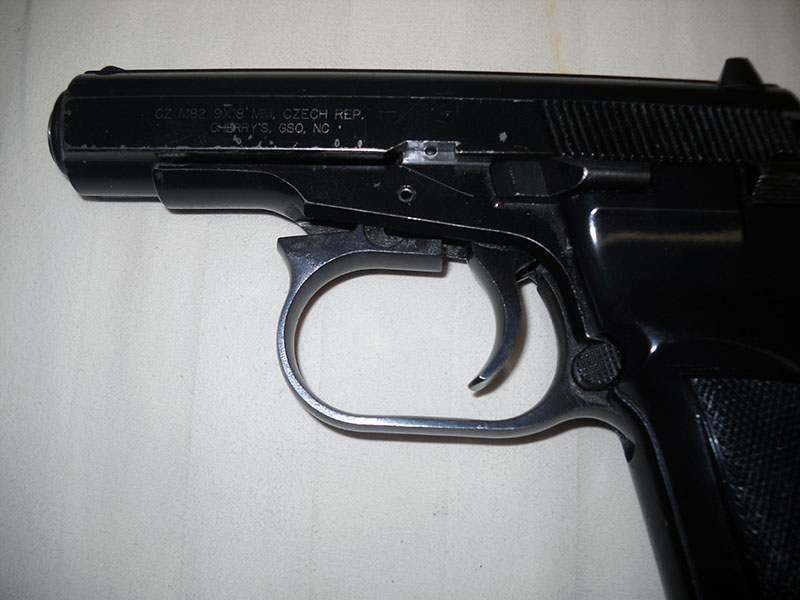
Anyway, back to the P1001. There's not much more to tell, really. Its rather slipshod grip panels are the only obvious sign of what we might call stereotypical Eastern Bloc construction, which we might expect, since the East Germans might have been Communists, but they were still Germans. :) That round feature behind the magazine well looks like a plug filling what would originally have been the swivel for a lanyard loop, except as far as I know, PPs that were equipped for lanyards had them attached to a bracket on the side, similar to the P38, rather than on a butt swivel. As such, I'm not sure what that's supposed to be for.
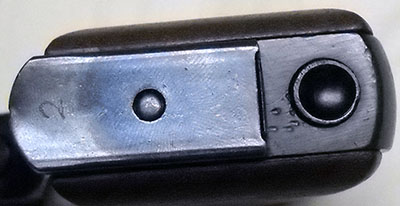
Also, annoyingly, the East Germans decided to omit the classic Walther finger rest from the magazine, so there is nowhere for the shooter's pinky to go. The man who sold it to me said he had tested it with a regular PP magazine and it had worked fine, so a while after I got this one, I tracked down a proper (aftermarket) PP magazine with a finger rest.
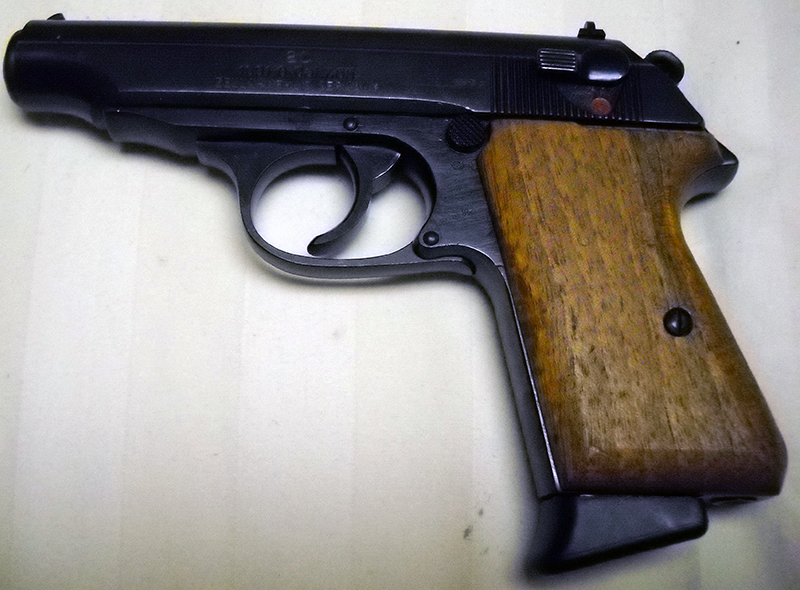
I have not yet found out how well that works as a magazine, but it certainly looks the part more, and is more comfortable to hold. One of these days I may also look around and see if I can find just the pinky-rest floorplate to add to the original magazine as well.
Operational details: The PP was eventually offered in .380 ACP and (a bit oddly) .22 LR, but the P1001 is still in the original PP caliber of 7.65mm Short (.23 ACP). Magazine capacity is seven rounds. Sights are the usual rudimentary-but-serviceable small-European-auto blade and notch. The PP has a single-or-double-action trigger with a decocking safety, and I believe was one of the first pistols to feature this now-virtually-standard arrangement. In less enduring details, note the slightly odd position of the magazine release button, and the fact that there is no external slide release.
The original PP remained in production until quite recently. Today, the only variant I know still to be in production is the stainless steel, .22-caliber version of the PPK/S, which is a PPK slide on a PP grip frame for obscure reasons having to do with the changes to American firearms import regulations in 1968. Doubly weirdly, the PPK/S is made in the USA now, which means there is actually no reason to keep using those strange proportions and not just make proper PPKs. Go figure.
--G.